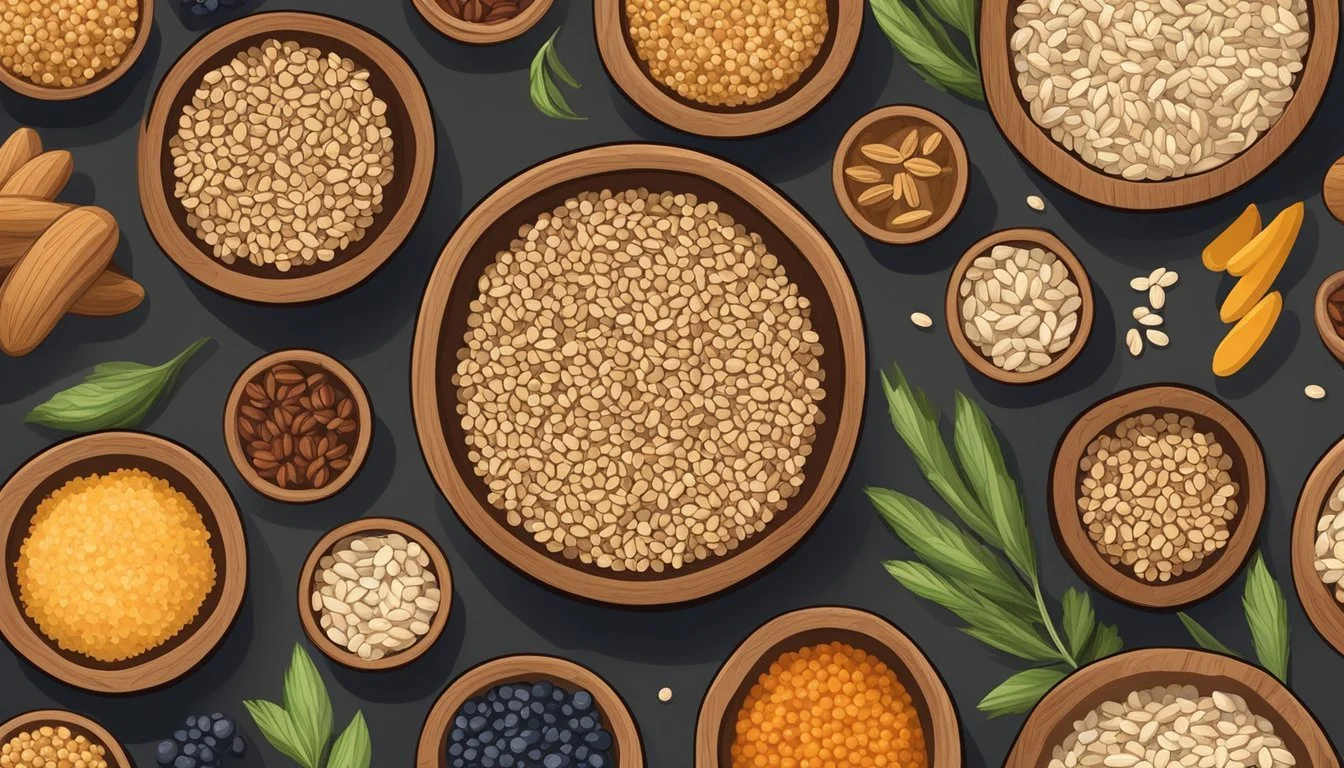Spelt Berries Substitutes
Top Alternatives for Your Recipes
For those seeking alternatives to spelt berries, several substitutes can effectively elevate your culinary creations while maintaining nutritional value. Whole wheat flour is a direct substitute that matches spelt berries in terms of nutrition and density, making it an excellent 1:1 replacement. This makes whole wheat flour not only a convenient substitute but also a nutritionally comparable option for health-conscious cooks.
Another great grain to consider is quinoa, which offers a versatile and nutritious alternative. Quinoa is rich in protein and can seamlessly replace spelt berries in a variety of recipes, from salads to baked goods. Additionally, barley provides a hearty substitute that can enhance the texture and flavor of your dishes.
Exploring these substitutes opens up numerous possibilities for those looking to diversify their recipes. Whether it's for dietary needs or simply to try something new, these alternatives are sure to add a new twist to your culinary adventures.
Understanding Spelt Berries
Spelt berries, an ancient grain, stand out due to their rich nutritional profile and versatility in cooking, offering numerous health benefits from their high dietary fiber and essential nutrients.
Nutritional Benefits of Spelt
Spelt berries are a nutritional powerhouse. One cup of cooked spelt offers approximately 246 calories, 10 grams of protein, and 2 grams of fat. This ancient grain is also an excellent source of dietary fiber, providing about 8 grams per cup, which supports digestion and overall gut health.
Additionally, spelt berries contain vital vitamins and minerals such as magnesium, iron, and zinc. Magnesium helps with muscle function, iron supports red blood cell production, and zinc plays a role in immune function. These elements contribute significantly to balanced nutrition.
Culinary Uses of Spelt Berries
Spelt berries can be cooked similarly to rice, requiring a water-to-spelt ratio of 5:1 and simmering until tender, typically for 45 minutes to an hour. Their chewy texture and nutty flavor make them suitable for a variety of dishes.
They are often used in soups, salads, and grain bowls. In baking, spelt flour can substitute for all-purpose or whole wheat flour, requiring slight adjustments in liquid content due to its different absorption rates. This versatility enhances both sweet and savory recipes.
Common Substitutes for Spelt Berries
Spelt berries offer a unique flavor and nutrient profile, but several substitutes can be used when they are not available. Options vary based on flavor similarity, gluten content, and nutritional benefits.
Grains with Similar Nutty Flavor
Farro: Farro closely resembles spelt berries in both texture and taste. It's chewy and features a nutty profile, making it suitable for salads and pilafs.
Kamut: With a similar ancient grain origin, Kamut also provides a nutty flavor and chewy texture. It's often used in place of spelt berries in soups and stews.
Einkorn: This grain offers a slightly sweeter taste while maintaining the chewy, nutty characteristics of spelt. It works well in bread, porridge, and grain bowls.
Gluten-Free Alternatives for Spelt Berries
Quinoa: Quinoa is a versatile, gluten-free alternative, offering a slightly nutty and earthy flavor. It’s packed with protein and can substitute spelt berries in salads and side dishes.
Amaranth: Another gluten-free option, amaranth has a mildly tangy taste and a slightly crunchy texture. It's suitable for porridges, soups, and baking.
Rice: Brown rice, particularly, mimics the chewy texture of spelt berries. It lacks the nutty flavor but can be used in numerous dishes, from casseroles to salads.
Substitutes with Comparable Nutrition
Whole Wheat Berries: These offer a similar nutritional profile to spelt berries, including high fiber and protein content. Whole wheat berries work well in recipes needing a chewy texture and hearty flavor.
Barley: Barley is rich in dietary fiber and essential minerals. Its chewy texture and mild flavor make it a good choice for soups, stews, and grain salads.
Einkorn: In addition to flavor, einkorn provides comparable nutritional benefits to spelt. It's an excellent source of protein, fiber, and micronutrients, suitable for various recipes requiring a nutritious grain.
Grain Alternatives in Cooking and Baking
Finding the right substitute for spelt berries can enhance the flavor, texture, and nutritional value of your dishes. This section focuses on alternative grains suited for various culinary uses, including baked goods, savory dishes, salads, and side dishes.
Replacing Spelt in Baked Goods
When substituting spelt in baked goods, all-purpose flour and whole wheat flour are the most straightforward choices. All-purpose flour is versatile and widely available, requiring minimal adjustments to recipes.
Whole wheat flour offers more fiber and nutrients.
For a gluten-free option, oat flour provides a chewy texture and slightly sweet flavor, while buckwheat flour adds an earthy taste. Einkorn flour is another excellent choice, being both nutrient-dense and slightly sweet.
Alternative Grains for Savory Dishes
Freekeh and buckwheat are exceptional alternatives to spelt in soups, stews, pilafs, and risottos. Freekeh is young, roasted wheat, imparting a smoky flavor ideal for hearty dishes.
Buckwheat is gluten-free and lends a robust, nutty taste.
Kamut flour can be used as a thickener in soups and stews, bringing a rich, buttery flavor. Barley flour is also a valuable substitute, adding depth and texture to savory recipes.
Best Substitutes for Spelt in Salads and Side Dishes
For salads and side dishes, consider quinoa, farro, and brown rice. Quinoa is protein-rich and offers a slightly nutty flavor, making it ideal for cold salads.
Farro, similar in texture to spelt, provides excellent chewiness.
Brown rice is another good alternative, offering a neutral taste and firm texture. Wild rice can add a unique, earthy flavor and is perfect for warm and cold salads alike. Einkorn grains are also highly nutritious and work well in various side dishes.
Health Considerations When Choosing Substitutes
Choosing spelt berry substitutes requires careful attention to gluten sensitivities, allergies, and maintaining nutritional balance. Specific substitutes can effectively support these health needs while offering similar culinary benefits.
Navigating Gluten Sensitivities and Allergies
For individuals with celiac disease or gluten intolerance, selecting spelt berry substitutes can seem challenging. Spelt contains gluten, making it unsuitable for those with these conditions. Substitutes like quinoa, millet, and buckwheat offer gluten-free alternatives.
These grains provide robust flavor and texture without triggering adverse health reactions. Wheat allergies also necessitate choosing grains that are free from any wheat derivatives. Careful label reading is essential to ensure these substitutes do not contain traces of gluten or wheat.
Maintaining Nutritional Balance with Substitutes
Replacing spelt berries with alternatives must also consider nutritional balance. Spelt berries are rich in fiber, protein, and essential minerals. Effective substitutes should offer comparable benefits.
Quinoa is a strong candidate, with high protein content and a full amino acid profile. Millet and amaranth provide excellent fiber and vitamin contents, which help maintain digestive health. Adjusting dietary plans to include a mix of these substitutes can help sustain overall nutritional intake.
Using a variety of substitutes ensures a rich and balanced diet, covering the essential macronutrients needed for healthy living. It’s important to adapt recipes to maintain similar nutritional benefits when swapping ingredients.
Shopping for Spelt Berries and Their Substitutes
When shopping for spelt berries and their substitutes, it's important to know where to look in both physical stores and online. Awareness of gluten-free options and other ancient grains is beneficial for making informed choices.
Finding Spelt Berries in Stores
Spelt berries are often found in the health food or organic grain sections of many supermarkets. Stores specializing in natural foods or bulk grains are also good places to check. Larger chain supermarkets may stock spelt berries in their health food aisles, while independent health food stores might offer a more diverse selection.
Look for bulk bins as purchasing in bulk can often be more cost-effective. Ensure to check the packaging for freshness and avoid any with damaged or torn seals. For those with wheat allergies, note that spelt contains gluten, albeit sometimes more tolerable for some individuals.
Purchasing Substitutes Online and Locally
For those unable to find spelt berries or looking for alternatives, online retailers like Amazon and specialty food websites are valuable resources. Whole wheat flour, einkorn flour, and Kamut flour are commonly available substitutes that can be found at both local grocery stores and online platforms.
Whole wheat flour can typically replace spelt on a 1:1 basis. Einkorn flour, known for its sweet, nutty flavor, and Kamut flour, noted for its rich, buttery taste, provide great alternatives. Gluten-free options like quinoa or buckwheat, available both online and in health food stores, serve those with gluten sensitivities.
When shopping online, ensure to read product descriptions and reviews to ensure the best quality. Local farmers' markets might also offer these ancient grains, providing an opportunity to support local agriculture. Always compare prices and check for the best deals when buying in larger quantities.
Additional Tips for Using Spelt Berry Substitutes
When substituting spelt berries, consider the nutritional differences, cooking adjustments, and how the flavor and texture profiles will change. These tips will help in achieving the best results.
Adjusting Recipes for Different Grains
Different grains may require adjustments in cooking times and water ratios. Whole wheat berries, for example, need a longer cooking time than spelt berries. A ratio of 2.5 cups of water per cup of grain is common for many substitutes.
Kamut also requires careful monitoring, as its rich, buttery flavor can overpower some dishes if not balanced properly. Quinoa, although not a direct substitute, offers similar benefits in protein and fiber content, aiding digestion and providing essential nutrients. It typically cooks faster, around 15-20 minutes with a 2:1 water ratio.
Understanding Flavor and Texture Differences
Grains like einkorn or farro have unique flavor profiles that can impact the final dish. Einkorn imparts a sweet, nutty flavor, closely mimicking spelt. Farro brings a chewy texture, suitable for salads and soups.
Whole wheat has a denser texture and more robust taste, making it ideal for hearty dishes. Barley offers a chewy, slightly sweet flavor but requires more cooking time. Recognizing these differences is crucial for not compromising the dish’s intended taste and texture.
Incorporate bulgur for a soft texture that quickly absorbs flavors from other ingredients. Each substitute will slightly alter the dish, so tasting and adjusting seasoning throughout the cooking process is essential for achieving the best results.




